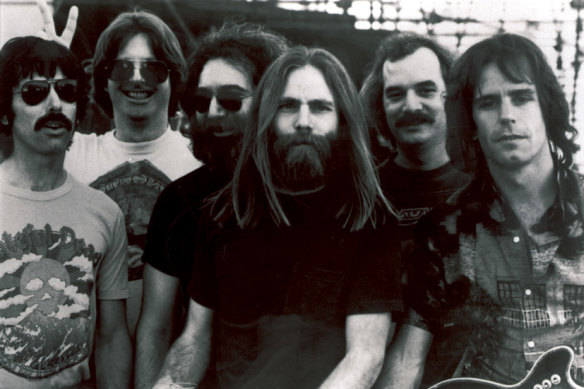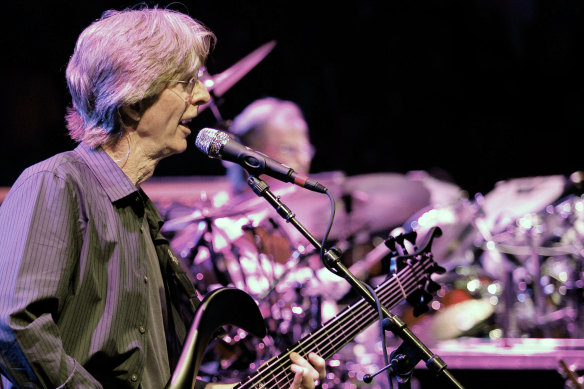
Lesh credited Garcia with teaching him to play bass in the unorthodox lead-guitar style that he would become famous for, mixing thundering arpeggios with snippets of spontaneously composed orchestral passages.
Fellow bass player Rob Wasserman once said Lesh’s style set him apart from every other bassist he knew of. While most others were content to keep time and take the occasional solo, Wasserman said Lesh was both good enough and confident enough to lead his fellow musicians through a song’s melody.

Members of the Grateful Dead, from left to right: Mickey Hart, Phil Lesh, Jerry Garcia, Brent Mydland, Bill Kreutzmann, and Bob Weir in undated file photo.Credit: AP Photo/File
“He happens to play bass but he’s more like a horn player, doing all those arpeggios – and he has that counterpoint going all the time,” he said.
Lesh began his long musical odyssey as a classically trained violinist, starting with lessons in third grade. He took up the trumpet at 14, eventually earning the second chair in California’s Oakland Symphony Orchestra while still in his teens.
But he had largely put both instruments aside and was driving a mail truck and working as a sound engineer for a small radio station in 1965 when Garcia recruited him to play bass in a fledgling rock band called The Warlocks.
When Lesh told Garcia he didn’t play the bass, the musician asked, “Didn’t you used to play violin?” When he said yes Garcia told him, “There you go, man.”

Lesh performs with The Dead in Los Angeles in 2009.Credit: AP/Richard Vogel
Armed with a cheap four-string instrument his girlfriend bought him, Lesh sat down for a seven-hour lesson with Garcia, following the latter’s advice that he tune his instrument’s strings an octave lower than the four bottom strings on Garcia’s guitar. Then Garcia turned him loose, allowing him to develop the spontaneous style of playing that he would embrace for the rest of his life.
Lesh and Garcia would frequently exchange leads, often spontaneously, while the band as a whole would frequently break into long experimental, jazz-influenced jams during concerts. The result was that even well-known Grateful Dead songs like Truckin’ or Sugar Magnolia rarely sounded the same two performances in a row, something that would inspire loyal fans to attend show after show.
“It’s always fluid, we just pretty much figure it out on the fly,” Lesh said, chuckling, during a rare 2009 interview with the Associated Press. “You can’t set those things in stone in the rehearsal room.”
Loading
Phillip Chapman Lesh was born on March 15, 1940, in Berkeley, California, the only child of Frank Lesh, an office equipment repairman, and his wife, Barbara.
He would say in later years that his love of music came from listening to broadcasts of the New York Philharmonic on his grandmother’s radio. One of his earliest memories was hearing the great German composer Bruno Walter lead that orchestra through Brahms’ First Symphony.
Musical influences he often cited were not rock musicians but composers like Bach and Edgard Varese, as well as jazz greats like John Coltrane and Miles Davis.
Lesh had gravitated from classical music to cool jazz by the time he arrived at the College of San Mateo, eventually becoming first trumpet player in the school’s big band and a composer of several orchestral pieces the group performed.
Loading
But he set the trumpet aside after college, concluding he didn’t have the lung power to become an elite player.
Soon after he took up the bass, the Warlocks renamed themselves the Grateful Dead and Lesh began captivating audiences with his dexterity. Crowds gathered in what came to be known as “The Phil Zone” directly in front of his position on stage.
Although he was never a prolific songwriter, Lesh also composed music for, and sometimes sang, some of the band’s most beloved songs. Among them were the upbeat country rocker Pride of Cucamonga, the jazz-influenced Unbroken Chain and the ethereally beautiful Box of Rain.
Lesh composed the latter on guitar as a gift for his dying father, and he recalled that Grateful Dead lyricist Robert Hunter, upon hearing the instrumental recording, approached him the next day with a lyric sheet. On that sheet, he said, were “some of the most moving and heartfelt lyrics I’ve ever had the good fortune to sing”.
The band often closed its concerts with the song.
After the group’s dissolution following Garcia’s death in 1995, Lesh often skipped joining the other surviving members when they got together to perform.
He did take part in a 2009 Grateful Dead tour and again in 2015 for a handful of “Fare Thee Well” concerts marking both the band’s 50th anniversary and what Lesh said would be the last time he would play with the others.
He did continue to play frequently, however, with a rotating cast of musicians he called Phil Lesh and Friends.
In later years he usually held those performances at Terrapin Crossroads, a restaurant and nightclub he opened near his northern California home in 2012, which was named after the Grateful Dead song and album Terrapin Station.
Lesh is survived by his wife, Jill, and sons Brian and Grahame.
AP
Get the day’s breaking news, entertainment ideas and a long read to enjoy. Sign up to receive our Evening Edition newsletter here.









 Add Category
Add Category